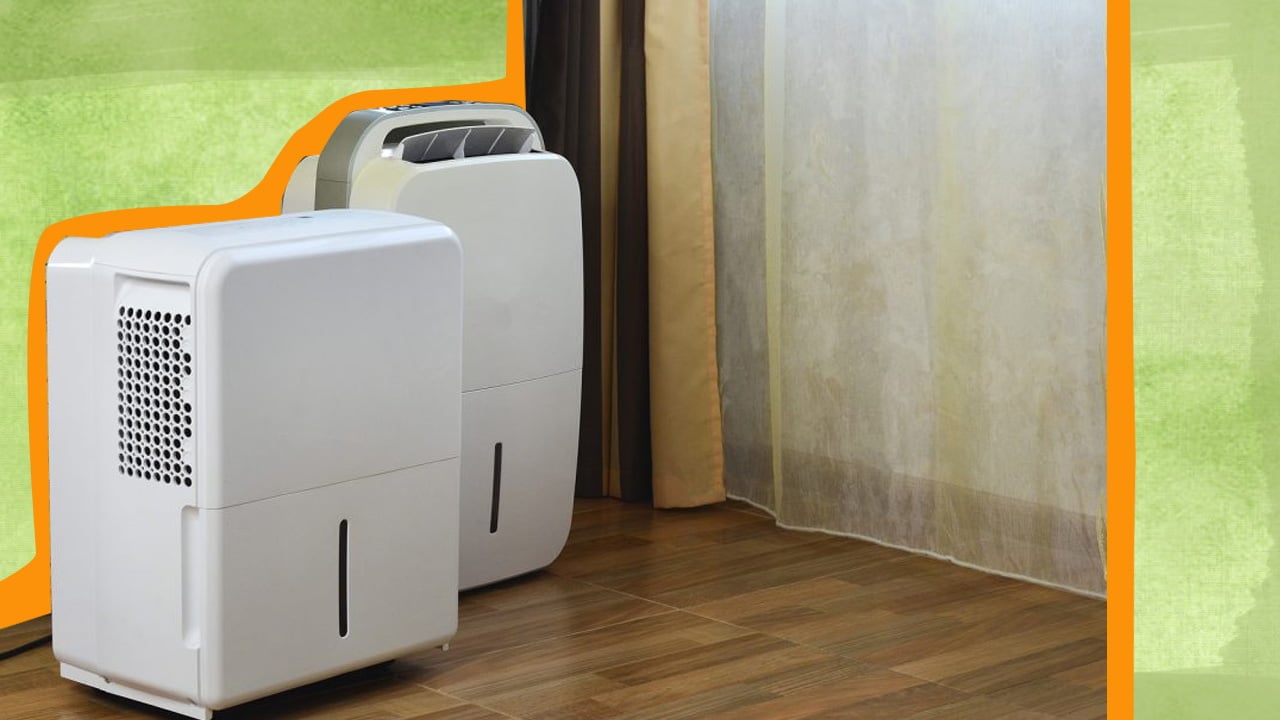Air conditioners are better suited for basement bedrooms in moderate or low-humidity environments, while dehumidifiers work better in a high-humidity living space. Both can be run simultaneously for best results if the bedroom is hot and extremely humid.

Basements can be hot and damp places desperately in need of significant cooling, particularly during the summer months.
Not only does this make the basement an uncomfortable place to be in, but it also poses a health risk in the form of allergens. This is where an air conditioner or a dehumidifier can help you out. But the trouble is, it can be difficult to know which one to use for cooling a basement bedroom.
Wondering what is better for a basement bedroom: air conditioner or dehumidifier? Let’s look at the merits of each Heating, Ventilation and Air Conditioning (HVAC) system and how well they work in a basement bedroom.
How A Dehumidifier Works

The primary purpose of a dehumidifier is to remove moisture from the air. Of course, this doesn’t cause the air to cool down, but the resulting dryness of the air can make your room feel a little cooler.
A dehumidifier achieves this by pulling in moist air and cooling it down enough for all the moisture to condense and separate from the air. The condensed moisture is then collected in a removable bucket or tray, which has to be cleaned periodically.
You can place a dehumidifier in a room without any external vents since the device doesn’t expel any hot air into the room. And since there is no external unit associated with dehumidifiers, the device can simply be placed in a room without any additional installation requirements.
Now, the dehumidification process works in one of three different ways, and this process is what determines the cost and effectiveness of a dehumidifier. What follows is a brief summary of each type of dehumidifier and how they work.
1. Desiccant Dehumidifiers
If you’ve ever purchased electronic equipment, you may have seen packets of silica gel. The purpose of these pouches is to absorb moisture from the box they are placed in, creating a dry environment for the device. And the material used in these pouches is known as a desiccant.
A desiccant dehumidifier works on the same principle, using a desiccant wheel for drying the surrounding air. Air passes through the wheel as it rotates, allowing the desiccant to absorb the moisture and expel dry air. And the condensed moisture is then collected in a tray or expelled from the device through a hose.
Tip
Desiccant humidifiers can operate at temperatures that are much lower than what most basement dehumidifiers can handle. Meaning, you can reliably use a desiccant humidifier to remove moisture from your basement bedroom during winters and warm summer months alike.
2. Refrigerant Dehumidifiers
As the name suggests, refrigerant dehumidifiers make use of refrigerant for the dehumidification process, similar to refrigeration technology used in fridges. These devices cool down a metal plate, upon which the moisture from the air condenses. And to direct air toward this metal plate, the dehumidifier uses a high-speed fan. Once the moisture condenses, it drips down the metal plate into a dedicated water tank.
Typically, a refrigerant dehumidifier is best used at room temperature. Its performance will drop significantly when the temperature lowers, making it ill-suited for cooler climates. However, in temperate regions, this type of dehumidifier can be quite effective at lowering the uncomfortable humidity levels in your basement bedroom.
3. Whole-House Ventilation Dehumidifiers
Whole-house ventilating dehumidifiers can be one of the most effective ways of removing moisture from your entire house. Being more economically efficient than most plug-in dehumidifiers, you can leave the system on and let it do the rest.
The system is placed in the loft space, from where it pushes dry air to your basement bedroom through a grill that is often unnoticeable. It works by constantly replacing damp air from your rooms and replacing them with cleaner, drier air. As a result, your basement bedroom will see less moisture and condensation buildup..
How An Air Conditioner Works
The primary function of an air conditioner is to lower the ambient temperature and reduce the relative humidity levels. It achieves this through the combination of several working components, namely the evaporator, the compressor, the condenser, and the expansion valve. Naturally, this makes air conditioning a complex affair from a technical standpoint.
The gist of the workings of an air conditioner is that the device makes use of a refrigerant as its primary coolant. This process begins with the device cooling the refrigerant down, after which the fluid is run through the evaporator coils. The fans behind the evaporator coils direct the cold air into the room, and lastly, the heat present in the room is absorbed by the refrigerant.
Next, the now-gaseous refrigerant is sent to the compressor, where it is then compressed into a high-pressure gas. The refrigerant then flows through the condenser coils, after which fans blow over it to reduce its heat. Once cooled down, the refrigerant returns to its natural liquid state and is ready to be reused again.
The trouble with ACs is that basements typically don’t have a window or any ventilation for ample air circulation. Unless your basement bedroom has an opening big enough to install an air conditioner, it’s better to look at options dedicated to basements instead. Window ACs and Evaporative ACs are not ideal for basements for these reasons.
There are four kinds of ACs, however, that can function well in a basement. These are wall-hung split air conditioners, ducted air conditioners, and portable air conditioners.
1. Wall-Hung Split Air Conditioners
A wall-hung split air conditioner comprises two units, with one placed in your desired room and the other installed outside. These are mounted high up on the wall and are connected to the external unit through a couple of tubes.
Split air conditioner models are one of the better options for cooling your basement bedroom. The external unit is the noisiest part of the AC, and since it is placed outside, there won’t be any echoes inside. And while they cost more than other AC unit types upfront, their overall running costs are quite low. You can opt for an air conditioner that comes with an inverter to further lower the running cost.
2. Ducted Air Conditioning
Also known as central air conditioning, ducted air conditioning is one of the cheapest ways of cooling your home. It involves a network of ducts installed all over your home, which can lead to extensive modification to the home structure. Thus, the upfront cost of these units is among the highest.
The main cooling unit is placed away from the rooms it cools, which is often on the roof. And other than the visually understated vents and controls, there are no signs of an air conditioning unit inside the home.
Ducted air conditioning units may very well be the optimal way of cooling your basement bedroom, as it works similarly to whole-house ventilation dehumidifiers.
3. Portable Air Conditioners
Portable air conditioners are highly mobile cooling devices that can regulate the temperature in small rooms effectively. These are easy to install and take up little floor space, which can be convenient for when you don’t use them. You can find battery-powered AC units as well if your basement doesn’t have a power outlet nearby or if you want an energy-efficient option.
For most basements, your options will be narrowed down considerably, as most of these requirements to be placed near a window to work well. Even so, there are ventless models on the market that can work with just a hose, without requiring a window.
Dehumidifiers And ACs: Where They Overlap And Differ
Air conditioners do reduce the humidity level in a given space to some extent, which is where they overlap in functionality with dehumidifiers. Both devices are a way to offer ventilation in a room where there isn’t enough of it. Additionally, they come with an air filter that can keep dust mites and mold growth away from your room, resolving indoor air quality problems as a result.
The key difference here is the purpose they are meant to fulfill. In theory, you can use an air conditioner as a dehumidifier, but the results won’t be as effective as the latter. And the converse is also true, as a portable dehumidifier offers little in the way of temperature control. These differences are enough to be the deciding factor of which device suits your needs the best.
Something that can throw a wrench in this clear-cut decision is the fact that modern air conditioner units come with a dry setting. While not as effective as a dedicated dehumidifier, you can make do with an air conditioner as your dehumidification device in a moderate humidity level. ACs remove excess moisture while pushing cool air, after all.
Dry settings in modern ACs can be a bit finicky to get right, as it largely depends on the size of your unit. If your unit is appropriately sized or a little smaller, the dry setting will work perfectly well. However, if the air conditioner is larger than necessary, you’ll find that the room has cooled down well before the AC unit can begin dehumidifying.
With all that in mind, a dehumidifier is a way to go if the relative humidity or moisture levels surpass 60% in your locale.
Running Both Simultaneously
If you live in a temperate or highly humid climate, running an AC unit and a dehumidifier may very well be the solution your basement bedroom needs. With fewer moisture levels in the air, air conditioners work more efficiently, making the dehumidifier-AC combo quite good at ambient atmosphere regulation.
The primary aim of using this combo is that the air conditioner has to expend extra electricity to reduce the humidity levels in the air. But if a dehumidifier is used beforehand, the AC unit will bring the room temperature to the desired level in an energy-efficient manner. It can also help reduce the electric bill.
The energy consumption of dehumidifiers is significantly lesser than what an air conditioner alone consumes in an environment with humid air. Additionally, running the two devices together will help add years to the lifespan of your AC unit due to the extra load taken off.

Conclusion
The answer to the conundrum of choosing a dehumidifier or air conditioner for a basement bedroom is three-fold. And the correct option depends largely on where you live and what kind of an environment is in your basement bedroom.
You can safely choose an air conditioner if the humidity levels in your locale never exceed 60%. Air conditioners are capable of reducing excess humidity well while regulating temperature significantly.
And if you live in an area that faces high rainfall with high humidity levels, a dehumidifier is the way to go. Not only will this make your bedroom more comfortable, but lowered humidity levels are also beneficial for your health.
Lastly, if you live in a humid environment that is also extremely hot, consider running both devices together. The combination of dehumidification and air conditioning will keep your basement bedroom comfortable and within healthy humidity levels.
